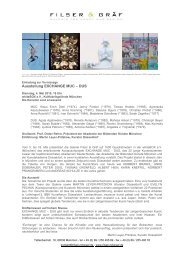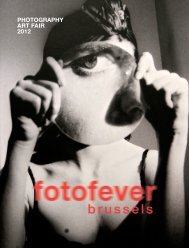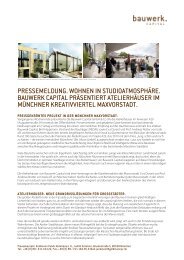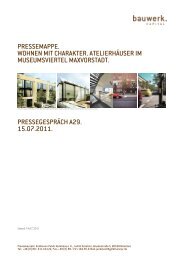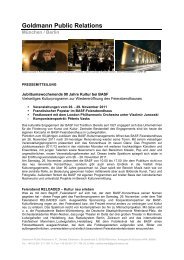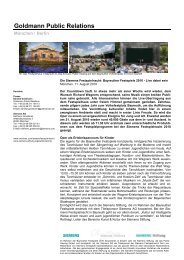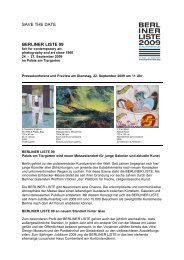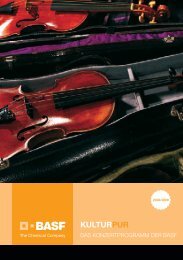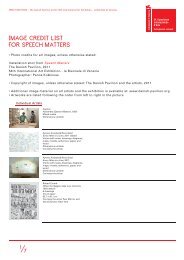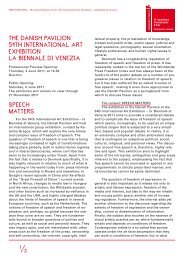Unmapping the City: Perspective of Flatness
Unmapping the City: Perspective of Flatness
Unmapping the City: Perspective of Flatness
You also want an ePaper? Increase the reach of your titles
YUMPU automatically turns print PDFs into web optimized ePapers that Google loves.
<strong>Unmapping</strong> <strong>the</strong> <strong>City</strong>
<strong>Unmapping</strong> <strong>the</strong> <strong>City</strong><br />
<strong>Unmapping</strong> <strong>the</strong> <strong>City</strong><br />
8 9
<strong>Unmapping</strong> <strong>the</strong> <strong>City</strong><br />
<strong>Unmapping</strong> <strong>the</strong> <strong>City</strong><br />
10 11
<strong>Unmapping</strong> <strong>the</strong> <strong>City</strong><br />
17
<strong>Unmapping</strong> <strong>the</strong> <strong>City</strong><br />
<strong>Unmapping</strong> <strong>the</strong> <strong>City</strong><br />
20 21
<strong>Unmapping</strong> <strong>the</strong> <strong>City</strong><br />
<strong>Unmapping</strong> <strong>the</strong> <strong>City</strong><br />
56 57
<strong>Unmapping</strong> <strong>the</strong> <strong>City</strong><br />
<strong>Unmapping</strong> <strong>the</strong> <strong>City</strong><br />
58 59
<strong>Unmapping</strong> <strong>the</strong> <strong>City</strong><br />
<strong>Unmapping</strong> <strong>the</strong> <strong>City</strong><br />
60 61
<strong>Unmapping</strong> <strong>the</strong> <strong>City</strong><br />
<strong>Unmapping</strong> <strong>the</strong> <strong>City</strong><br />
74 75
<strong>Unmapping</strong> <strong>the</strong> <strong>City</strong>: <strong>Perspective</strong><br />
<strong>of</strong> <strong>Flatness</strong><br />
Edited by Alfredo Cramerotti<br />
Outline<br />
<strong>Unmapping</strong> <strong>the</strong> <strong>City</strong>, <strong>the</strong> first title in <strong>the</strong> new Intellect series ‘Critical Photography’,<br />
features photographs shot between 2004 and 2008 in fourteen different cities around <strong>the</strong><br />
world. The images are linked by <strong>the</strong>ir shared attempts to define a two-dimensional<br />
approach to a three-dimensional built reality, and to address spatial representation and<br />
urbanity through art. In representing <strong>the</strong> cityscape through a flat texture <strong>of</strong> lines and<br />
minimal colour tones, <strong>the</strong>y draw <strong>the</strong> reader into a conversation about <strong>the</strong> interplay<br />
between reality and its representation.<br />
£14.95 | $25<br />
ISBN 9781841503165<br />
Paperback<br />
230x230mm<br />
2010<br />
Contents<br />
p. 06 Foreword 1<br />
The Editor to <strong>the</strong> Reader<br />
p. 24 <strong>Unmapping</strong> <strong>the</strong> <strong>City</strong>: <strong>Perspective</strong> <strong>of</strong> <strong>Flatness</strong>_Jonathan Willett<br />
The Art <strong>of</strong> Critical Practice<br />
The Urban <strong>Perspective</strong> <strong>of</strong> Modernity<br />
The Productive Gaze: From Flanuer to Aperture<br />
Surrealist <strong>Perspective</strong>s: The Unfamiliar <strong>City</strong><br />
Non-<strong>Perspective</strong>s: The Abstract <strong>City</strong><br />
The Versatile Photograph<br />
p. 52 A Middleword _Inês Moreira<br />
p.76 Bibliography
Excerpts<br />
In this book, <strong>the</strong> assemblage <strong>of</strong> photography and critical analysis is designed to produce a<br />
dialogue between knowing and seeing, a differential space where two systems <strong>of</strong><br />
representations work not to determine each o<strong>the</strong>r but to expand a common horizon <strong>of</strong><br />
possibility for photographic practice.<br />
In a photographic study developed over four years, <strong>Unmapping</strong> <strong>the</strong> <strong>City</strong> traverses <strong>the</strong><br />
history <strong>of</strong> modern aes<strong>the</strong>tics, connecting retrospective forms <strong>of</strong> abstraction to new<br />
perspectives in contemporary urban photography, a process shaped by <strong>the</strong> ‘implicit<br />
recognition <strong>of</strong> a historical transition from <strong>the</strong> representational priority <strong>of</strong> “surface” to that<br />
<strong>of</strong> “interface” ‘ (Victor Burgin).<br />
The photographic effect is to deconstruct <strong>the</strong> three-dimensional built environment in<br />
‘perspectives <strong>of</strong> flatness’, which in turn re-construct a sensibility toward <strong>the</strong> concrete,<br />
rationalized spaces <strong>of</strong> urban cartography.<br />
In <strong>the</strong> process, it re-instates a relationship between individual perception and <strong>the</strong> vast<br />
complexities <strong>of</strong> urban life.<br />
The photographer adopts <strong>the</strong> method <strong>of</strong> <strong>the</strong> psychoanalyst to retrieve a critical image <strong>of</strong><br />
<strong>the</strong> city, as <strong>the</strong> photograph restores to perception <strong>the</strong> information that remains absent, like<br />
a blind spot in <strong>the</strong> individual’s urban conscious.<br />
Emerging from <strong>the</strong> social and historical complexities <strong>of</strong> <strong>the</strong> urban environment are a<br />
thousand cities <strong>of</strong> <strong>the</strong> imagination, as <strong>the</strong> shadow architectures <strong>of</strong> perception. These o<strong>the</strong>r<br />
places are <strong>the</strong> yet to be experienced vicinities <strong>of</strong> <strong>the</strong> city, <strong>the</strong> interstitial places that<br />
materialize in <strong>the</strong> gaps between ‘perspective seeing’ and ‘perspective knowing’.<br />
In <strong>the</strong> ‘perspective <strong>of</strong> flatness’ <strong>the</strong> infra-structure <strong>of</strong> <strong>the</strong> modern city merges with <strong>the</strong><br />
info-structure <strong>of</strong> urban photography; a retrospective insight into <strong>the</strong> discourse <strong>of</strong><br />
Modernism, and a prospective lens through which to encounter <strong>the</strong> aes<strong>the</strong>tics <strong>of</strong> <strong>the</strong><br />
contemporary city.<br />
The ‘perspective <strong>of</strong> flatness’ becomes an urban interface between past and present,<br />
abstraction and actuality, a place for <strong>the</strong> architectural unconscious to emerge in <strong>the</strong><br />
photographic imagination.<br />
In <strong>the</strong> un-mapping <strong>of</strong> <strong>the</strong> city, in <strong>the</strong> oppositions <strong>of</strong> inside/outside, past/present, night/day,<br />
surface/depth, reality stutters at <strong>the</strong> edge <strong>of</strong> abstraction as <strong>the</strong> gaze becomes unstable, we<br />
don’t quite know where to fix our attention or what it is that we are supposed to be<br />
looking at; a window becomes an image, <strong>the</strong> image a screen, <strong>the</strong> screen a portal, which<br />
transports us to memories <strong>of</strong> a city long forgotten or places yet to be encountered.<br />
<strong>Unmapping</strong> <strong>the</strong> <strong>City</strong> requires <strong>the</strong> photographer to replace <strong>the</strong> cognitive frame <strong>of</strong><br />
representation with <strong>the</strong> perceptual register <strong>of</strong> affect. The result is an emergent form <strong>of</strong><br />
critical cartography, an encounter with <strong>the</strong> complexities <strong>of</strong> place, where visual sensation
displaces meaning in <strong>the</strong> counter-intuitive lens <strong>of</strong> <strong>the</strong> urban photographer who ‘thinks in<br />
pictures’.<br />
<strong>Unmapping</strong> <strong>the</strong> <strong>City</strong> abstracts a ‘journey-form’ from <strong>the</strong> psycho-geographic drift <strong>of</strong> <strong>the</strong><br />
derive. The presentation <strong>of</strong> different images side by side, juxtaposing two images to form<br />
a unique view <strong>of</strong> <strong>the</strong> same subject matter, amplifies <strong>the</strong> aes<strong>the</strong>tic <strong>of</strong> mobility as <strong>the</strong><br />
perspective in process counteracts <strong>the</strong> stillness <strong>of</strong> <strong>the</strong> photograph.<br />
As <strong>the</strong> unwieldy city ‘runs its course’, <strong>the</strong> photographer ‘transcodes’ <strong>the</strong> free associations<br />
<strong>of</strong> a filmic experience into <strong>the</strong> urban acrobatics <strong>of</strong> <strong>the</strong> free runner or traceur, who<br />
navigates <strong>the</strong> ‘open source’ city by improvising a route that goes ‘<strong>of</strong>f <strong>the</strong> map’, through<br />
unexplored and <strong>of</strong>ten unseen places in <strong>the</strong> urban landscape. In <strong>the</strong> photographic<br />
sequences we take a perspective detour, following <strong>the</strong> perspective <strong>of</strong> <strong>the</strong> free runner<br />
through enclaves, backstreets, stairwells and blind alleys.<br />
Urban experience is modified with such frequency that our shared sense <strong>of</strong> perspective<br />
disperses into a pathological state <strong>of</strong> abstraction, where life in <strong>the</strong> contemporary city and<br />
its environs is separated from human understanding. The ‘perspective <strong>of</strong> flatness’<br />
becomes a means <strong>of</strong> negotiating <strong>the</strong> conditions <strong>of</strong> contemporary urban life.



